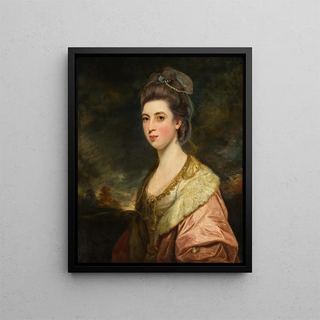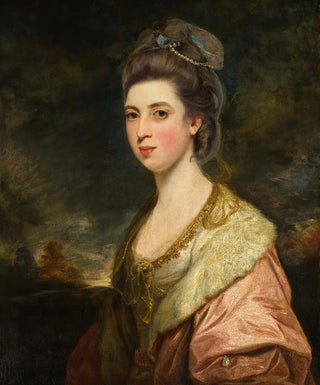Art print | Portrait of Mrs. Richard Pennant - Sir Joshua Reynolds


View from behind

Frame (optional)
Portrait of Mme Richard Pennant - Sir Joshua Reynolds – Captivating Introduction
The "Portrait of Mme Richard Pennant" by Sir Joshua Reynolds is an iconic work that embodies the very essence of 18th-century British portraiture. Created between 1778 and 1779, this painting depicts a woman with striking beauty, draped in sumptuous fabrics that evoke both grace and dignity. Delving into this piece, the viewer is immediately transported to a time when portrait art was not only a means of immortalizing faces but also a reflection of the social and cultural values of the era. The soft light caressing Mme Pennant's face, along with the choice of colors, creates an intimate and warm atmosphere, inviting prolonged contemplation.
Style and uniqueness of the work
Reynolds' style, marked by an exceptional mastery of light and color, reveals itself in every detail of this portrait. The artist employs glazing techniques that add depth and richness to the hues, giving an almost tangible texture to the sitter's clothing. Mme Pennant's gaze, both direct and filled with mystery, captures attention and establishes an emotional connection with the viewer. This painting stands out for its ability to transcend mere physical representation, evoking the feelings and thoughts of the person depicted. Reynolds manages to capture not only Mme Pennant's appearance but also her character, making her come alive and accessible to those who observe her. Beyond its aesthetic beauty, this portrait bears witness to an era when portraiture was a means of asserting one's status and identity within society.
The artist and his influence
Sir Joshua Reynolds, a central figure in British portraiture, redefined the standards of his time. As the first president of the Royal Academy of Arts, he played a pivotal role in promoting art in Great Britain. His innovative approach, blending classical tradition with modern sensibility, inspired many contemporary and future artists. Reynolds succeeded in establishing a balance between realism and idealization, creating works that continue to fascinate with their expressiveness. His influence extends beyond his era, leaving a lasting mark on the

Matte finish

View from behind

Frame (optional)
Portrait of Mme Richard Pennant - Sir Joshua Reynolds – Captivating Introduction
The "Portrait of Mme Richard Pennant" by Sir Joshua Reynolds is an iconic work that embodies the very essence of 18th-century British portraiture. Created between 1778 and 1779, this painting depicts a woman with striking beauty, draped in sumptuous fabrics that evoke both grace and dignity. Delving into this piece, the viewer is immediately transported to a time when portrait art was not only a means of immortalizing faces but also a reflection of the social and cultural values of the era. The soft light caressing Mme Pennant's face, along with the choice of colors, creates an intimate and warm atmosphere, inviting prolonged contemplation.
Style and uniqueness of the work
Reynolds' style, marked by an exceptional mastery of light and color, reveals itself in every detail of this portrait. The artist employs glazing techniques that add depth and richness to the hues, giving an almost tangible texture to the sitter's clothing. Mme Pennant's gaze, both direct and filled with mystery, captures attention and establishes an emotional connection with the viewer. This painting stands out for its ability to transcend mere physical representation, evoking the feelings and thoughts of the person depicted. Reynolds manages to capture not only Mme Pennant's appearance but also her character, making her come alive and accessible to those who observe her. Beyond its aesthetic beauty, this portrait bears witness to an era when portraiture was a means of asserting one's status and identity within society.
The artist and his influence
Sir Joshua Reynolds, a central figure in British portraiture, redefined the standards of his time. As the first president of the Royal Academy of Arts, he played a pivotal role in promoting art in Great Britain. His innovative approach, blending classical tradition with modern sensibility, inspired many contemporary and future artists. Reynolds succeeded in establishing a balance between realism and idealization, creating works that continue to fascinate with their expressiveness. His influence extends beyond his era, leaving a lasting mark on the






